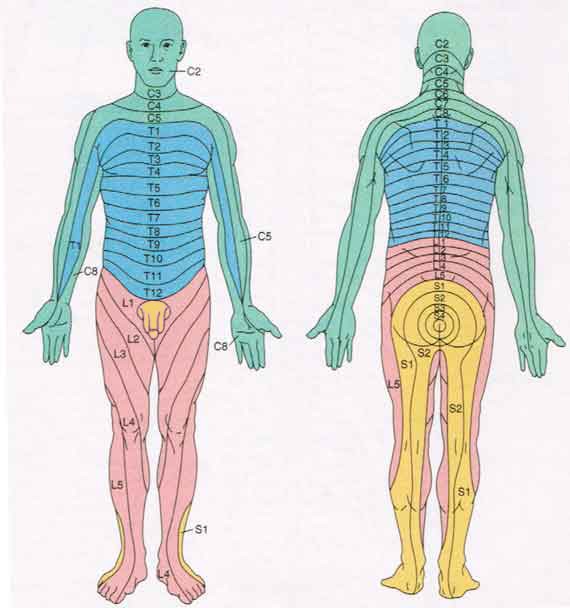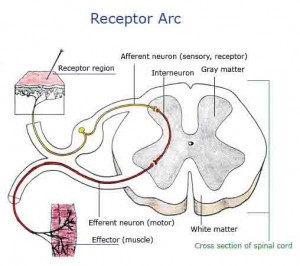The brain and spinal cord make up the central nervous system. The spinal cord, simply put, is an extension of the brain. It is an ovoid shaped column of nerve tissue that extends from the brain down to the second lumbar vertebrae. It allows us to control our arms, legs, and our bathroom habits, among many other things.
The spinal cord is enclosed in protective tissues called the meninges. The meninges form a protective sack around the spinal cord. Within the spinal (or dural) sac, the spinal cord is surrounded by a nourishing fluid called cerebrospinal fluid. The dural sac is further protected by the bones of the spinal column.
The internal anatomy of the spinal cord is quite complex. To keep things simple, the center of the cord consists of gray mater. White mater is arranged in tracts around the gray mater. It consists of axons that transmit impulses to and from the brain or between levels of gray mater within the spinal cord.
The spinal cord has two basic functions. The spinal cord carries sensory impulses to the brain (i.e. allows us to feel) and motor impulses (i.e. allows us to move our muscles) from the brain. The spinal cord also controls stretch reflexes and controls our bowel and bladder functions.
The spinal cord also acts as a nerve center between the brain and the rest of our body. Thirty-one pairs of nerves exit from the spinal cord to innervate our body.
Labeled Cross Section of Spinal Cord

- Anterior Fissure
- Deep groove along the front of the spinal cord
- Meninges
- The three membranes that cover and protect the spinal cord and brain—dura mater (outer), arachnoid (middle) and pia mater (inner)
- Pia Mater
- This thin vascular membrane of collagen fibers is the innermost layer of the three meninges that covers and protects the spinal cord and brain.
- Arachnoid
- The middle layer of the three meninges that covers and protects the spinal cord and brain.
- Subarachnoid Space
- The area between the arachnoid membrane and the pia mater
- Dura
- The outermost, toughest, and most fibrous of the three membranes that covers and protect the spinal cord and brain
- Gray Mater
- Gray mater is divided into three functional zones— the dorsal horns (sensory), the ventral horns (motor), and the middle zone (links the two horns). Gray mater is made up of neurons which are motor or sensory in nature.
- White Mater
- White mater consists of axons of neurons grouped in bundles that contain nerve fibers. These bundles travel between the spinal cord and the brain. Pathways to the brain are usually sensory, and pathways from the brain to the spinal cord are usually motor in nature.
- Sensory Root
- Collection of the cell bodies of the sensory nerves.
- Spinal Nerve
- Sensory and motor nerve rootlets merge to form a spinal nerve
Spinal Nerves
There are 31 pairs of spinal nerves that arise from the spinal cord. Each spinal nerve corresponds to the level it emerges from: there are 8 cervical, 12 thoracic (chest), 5 lumbar (lower back), and 5 sacral, and one coccygeal (tailbone) nerves. Each spinal nerve is attached to the spinal cord by two roots: a dorsal (or posterior) sensory root and a ventral (or anterior) motor root.
The fibers of the sensory root carry sensory impulses to the spinal cord —pain, temperature, touch and position sense (proprioception)—from tendons, joints and body surfaces. The motor roots carry impulses from the spinal cord to the muscles. The spinal nerves exit the spinal cord and pass through the intervertebral foramen.
Nerve Plexus
A nerve plexus is a network of multiple nerves. The spinal nerves in each part of the spine cluster together to form a plexus. Listed below are the named plexuses:
- Cervical plexus
- A network formed by the first 4 cervical spinal nerves. It innervates parts of the face, neck, shoulder and chest and gives rise to the phrenic nerve which controls the diaphragm (allows us to breath).
- Brachial plexus
- A network of the last 4 cervical and first thoracic spinal nerves. These nerves supply the shoulder, arm, forearm and hand.
- Lumbosacral plexus
- A network of lumbar and sacral nerves which supplies the lower extremity.
Map of Dermatomes
A dermatome is a band or region of skin supplied by a single sensory nerve. Sensory nerves carry sensory impulses to the spinal cord. Sensory impulses include pain, temperature, touch and position sense (proprioception)—from tendons, joints and body surfaces. Every part of the body has a dermatome that is supplied by a spinal nerve. The exception to this rule is the face, which is supplied by the cranial nerves.

Key to Spinal Nerve Regions
Each pair of spinal nerves links to one of four regions of the body.
- Cervical Region (green): 8 pairs of nerves supply the skin covering the back of the head, the neck, shoulders, arms and hands.
- Thoracic Region (blue): 12 pairs of thoracic nerves supply the skin on the chest, back and under arms
- Lumbar Region (pink): 5 pairs of lumbar nerves supply the skin on the lower abdomen, thighs and fronts of the legs
- Sacral Region (yellow): Sacral nerves supply the skin on the rears of the legs, the feet and genital areas
Levels of principal dermatomes
- C5 — clavicles
- C5, C6, C7 — lateral parts of the upper limb
- C8, T1 — medial sides of the upper limb
- C6 — thumb
- C6, C7, C8 — hand
- C8 — ring and little fingers
- T4 — level of nipples
- T10 — level of umbilicus
- T12 — inguinal or groin regions
- L1 L2 L3 L4 — anterior and inner services of lower limb
- L4, L5, S1 — foot
- L4 — medial side of big toe
- S1. S2, L5 — posterior and outer surfaces of lower limbs
- S1 — lateral margin of foot and little toe
- S2, S3, S4 — perineum
Receptor Arc
In the nervous system there is a “closed loop” system of sensation (sensory), decision (brain), and reactions (motor). This process is carried out through the activity of afferent neurons (sensory), interneurons (spinal cord), and efferent (motor) neurons. This closed loop forms a receptor reflex arc. While most nerve stimuli are processed through the brain, this is receptor reflex arc is processed at the level of the spinal cord to allow for a lightning fast response.
Receptor reflex arcs allow for automatic responses to dangerous stimuli (pain, abnormal positioning of a limb) before you would otherwise think to respond to them. An example of this is the automatic withdrawal response that occurs when you accidentally touch something that is very hot. The receptor arc automatically responds by withdrawing your arm, before you can even think to do so — i.e. before you can even process that you’ve touched something hot.

